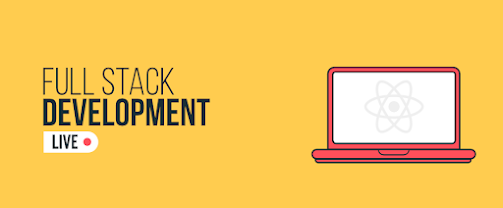Full-Stack Web Development In 7 Days: Master It Fast
What Is Full-Stack Web Development In 7 days Learn Best Review
Unlock
your potential in web creation and become a master in Full-Stack
Web Development in just 7 days. In this comprehensive course, we cover
everything you need to know to understand the fundamentals and build real-world
applications. Our expert instructors will guide you through the journey step by
step to help you gain the skills you need to succeed in the tech industry.
Why Learn Full-Stack
Web Development?
In a world where
businesses are increasingly dependent on their online presence, the demand for
skilled Full-Stack Web Developers is at an all-time high. By mastering
Full-Stack Web Development, you can create powerful, interactive, and
responsive web applications that keep users engaged and drive business growth.
Learning Full-Stack
Web Development in just 7 days can provide you with several benefits: cost and
time efficiency, accelerated learning outcomes, and a range of career
opportunities. It means you can start your development journey on a firm
footing and be ready to tackle new challenges head-on.
Click Here To Website Full-Stack Web Development In 7 days
Career Opportunities
The demand for
full-stack developers is not slowed down. From designing website layouts to
improving the functionality and speed of page loading, your skillset will be in
demand in various industries and organizations, from small businesses to global
corporations.
The Benefits of Taking
This Course
·
Learn the principles of Full-Stack Web Development in just 7
days
·
Create compelling and interactive web applications
·
Understand the entire web development process from start to
finish
·
Gain practical experience with real-world projects
·
Unlock career opportunities and command high salaries
The Basics of Web
Development
Before delving into
the complexities of Full-Stack Web Development, understanding the fundamental
building blocks of web pages is essential. HTML (HyperText Markup Language),
CSS (Cascading Style Sheets) and JavaScript collectively provide the core
functions of web page development.
HTML:
HTML is the standard
markup language used for creating web pages. It defines the structure and
layout of content within a web page using tags, attributes and elements. HTML
tags provide the overall structure of the web page, while attributes are used
to define characteristics of the HTML elements.
CSS:
CSS is used to style
and design the visual components of web pages, making them attractive and
user-friendly. It introduces a variety of features and functions that let you
customize colors, fonts, spacing, and more.
JavaScript:
JavaScript is a
programming language that enables interactive functionality on web pages,
making it dynamic and responsive to user interaction. It is commonly used for
designing online games, improving form validation, dynamic animations, and
enhancing user experience.
Understanding these
core concepts is essential for building dynamic and complex full-stack web
applications.
Introduction to
Front-End Development
Front-end development
is a vital component of full-stack
web development, and understanding it is essential for creating engaging
websites. In this section, we will cover some of the key concepts, frameworks,
and best practices for front-end development.
Frameworks and Libraries
Frameworks and
libraries are pre-written pieces of code that help developers create responsive
and feature-rich web applications quickly. Popular front-end frameworks include
Bootstrap, Foundation, and Materialize, which provide ready-made user interface
elements, typography, and other design elements to enhance the look and feel of
websites.
Responsive Design
Responsive design is
the process of creating websites that look and function perfectly across
various devices and screen sizes, from large desktops to small mobile phones.
It involves using CSS media queries, flexible grid systems, and images adapted
to multiple screen sizes.
User Experience
Optimization
User experience
optimization is about making websites easy and enjoyable to use. This involves
ensuring fast loading times, intuitive navigation, and clear calls-to-action.
Developers use various techniques, such as A/B testing and user feedback, to
enhance the user experience continually.
By the end of this
section, you will have a deep understanding of front-end development and the
skills to create compelling and interactive web pages.
Introduction to
Back-End Development
While front-end
development focuses on the look and feel of a website, back-end development
powers the behind-the-scenes functionality that makes a website work. In this
section of our Full-Stack Web Development in 7 Days course,
we'll introduce you to the world of server-side programming, databases, and
frameworks.
With our expert
guidance, you'll learn how to build dynamic and interactive web applications
that leverage powerful back-end tools. You'll gain a solid understanding of
programming languages like Python and Ruby, and put your skills to work using
powerful, open-source frameworks like Ruby on Rails and Flask.
In addition, we'll
take a deep dive into databases – the backbone of any data-driven web
application. You'll learn about SQL and No SQL databases, and explore database
design and management principles to ensure secure and efficient data storage
and retrieval.
By the end of this
section, you'll be equipped with all the tools you need to build robust,
scalable, and user-friendly web applications. Are you ready to unlock the full
potential of Full-Stack Web Development in just 7 days?
Database Management
and Design
Managing data is
critical for web applications, and a reliable database is essential. In this
section, you will explore the database management systems and relational
databases. Understanding the basics of data modeling, including
entity-relationship diagrams, is crucial.
Several approaches and
frameworks can be used to design databases, such as Waterfall and Agile. In
this course, you will learn how to design and optimize databases that can
support concurrent users and complex queries. Moreover, we will discuss how to
keep your database secure using access control and encryption.
Database Management
Systems
Database Management
Systems are software applications that can interact with databases. They enable
you to define, modify and query data in a database. The most prevalent types of
database management systems are Relational Database Management System (SQL), No
SQL and Cloud Database Management Systems, each with its advantages and
disadvantages.
|
Database Type |
Advantages |
Disadvantages |
|
Relational
Databases |
Easy
to use and integrate, they maintain data consistency, and provide high data
integrity. |
They
have limited scalability and can't support unstructured data, and can be more
complicated to set up and manage. |
|
No
SQL Databases |
They
are scalable, flexible, and can handle unstructured data more effectively
than relational databases. |
They
lack full transactions, which can lead to data integrity issues and
difficulties when querying data. |
|
Cloud
Databases |
They
have high security and reliability, are easy to manage, and autos cale to
handle traffic spikes. |
They
can be more expensive than other types of databases, have limited control
over the database, and have potential connectivity issues in low-bandwidth
areas. |
Relational Database
Design
Relational databases
store data in predefined tables with rows and columns, where each table represents
an entity such as an employee or a customer. A relational database can manage
relationships between tables, ensuring data consistency, integrity and enabling
complex queries.
Understanding how to
build and manage relational databases is essential. It involves designing the
tables, creating keys and constraints, and indexing the data for fast
retrieval. Normalization is a technique used to minimize redundancy, reducing
the risk of anomalies when manipulating data. Click Here To Website Full-Stack Web Development In 7 days
Salary Ranges
The salary of
full-stack developers depends on several factors, such as experience, industry,
and location. Here are the median salaries in the US (according to PayScale)
for popular career paths:
|
Career Path |
Median Salary |
|
Web
Developer |
$55k
- $87k |
|
Full-Stack
Developer |
$61k
- $113k |
|
Front-end
Developer |
$50k
- $93k |
|
Back-end
Developer |
$63k
- $118k |
|
Software
Engineer |
$63k
- $120k |
These figures indicate
the earning potential for skilled full-stack developers. As you gain more
experience, your salary will increase, and you'll be able to take on more
challenging and rewarding projects.
Conclusion
Mastering Full-Stack
Web Development in just 7 days is a remarkable feat, and you should be proud of
the skills and knowledge you've acquired. With a solid foundation in front-end
and back-end development, database management, and Dev Ops practices, you are
now well-equipped to build dynamic and interactive web applications.




Comments
Post a Comment